There are hundreds of songs about butterflies. Zero songs about the lowly cutworm.
It’s easy to understand why, despite the rhyming difficulties of a word like “butterfly.”
Butterflies enchant us. Their brilliant colors and graceful flight capture the eye and stir the imagination. They transform an ordinary garden into a magical sanctuary in a sea of suburban sameness.
The best way to attract them is to create an environment that gives them everything they need short of room service — in other words, a butterfly garden. This is Hotel Lepidoptera.
What’s a Butterfly Garden?
A butterfly garden is a specially curated area for butterflies and other pollinating insects. It’s a garden within a garden, with nectar-rich flowers and succulent host plants that support caterpillars throughout their life cycle.
Why Create a Butterfly Garden?
A butterfly garden offers benefits beyond the sheer pleasure of a yard populated with brilliant flitting insects.
- Butterflies, bees, and hummingbirds improve the pollination of nearby plants, including those in your vegetable garden.
- A butterfly garden contributes to the neighborhood’s biodiversity, elevating your status from crazy composter to environmental superhero.
- A butterfly garden is a living classroom to teach children about nature, conservation, and the importance of pollinators.
- A well-designed butterfly garden beautifies an outdoor space, whether a small balcony or a spacious back yard.
Common Butterfly Species in Southern California
Southern California, with its mild climate and diverse habitats, is home to approximately 170 butterfly species, including:
Monarch (Danaus plexippus)
Monarchs are known for their long migration and striking orange and black wings. Their life cycle spans about 2 to 6 weeks from egg to butterfly, but the generation that migrates can live up to 8 months. In Southern California, they’re most visible during their fall migration and again in spring as they return north. They can travel up to 3,000 miles during their migration, so please give them a break!
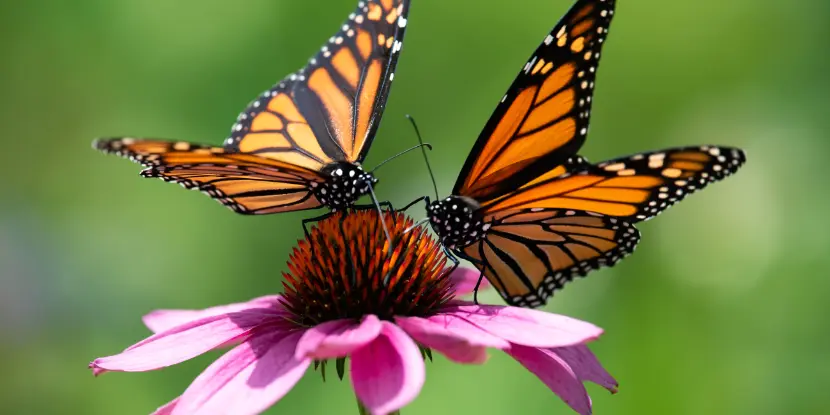
Two monarch butterflies feeding on a pink cone flower.
Western Tiger Swallowtail (Papilio rutulus)
This lepidopteran boasts yellow and black stripes reminiscent of a tiger’s coat. Its life cycle from egg to adult is approximately 6 to 8 weeks, and it’s most commonly seen in Southern California from early spring through late fall.
Painted Lady (Vanessa cardui)
Unlike their human counterparts, these Painted Ladies with distinct orange and black wings appear during daylight. They’re present in Southern California year-round.
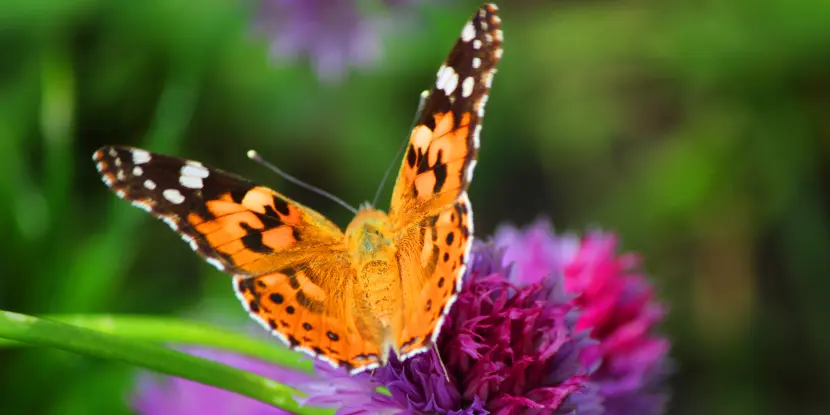
Close view of a painted lady butterfly flapping wings on a magenta chives flower.
Gulf Fritillary (Agraulis vanillae)
The Gulf Fritillary is a frequent visitor wherever the passion vine grows. Sadly, its population in California is declining due to a lack of native host plants and habitat loss. Please help!
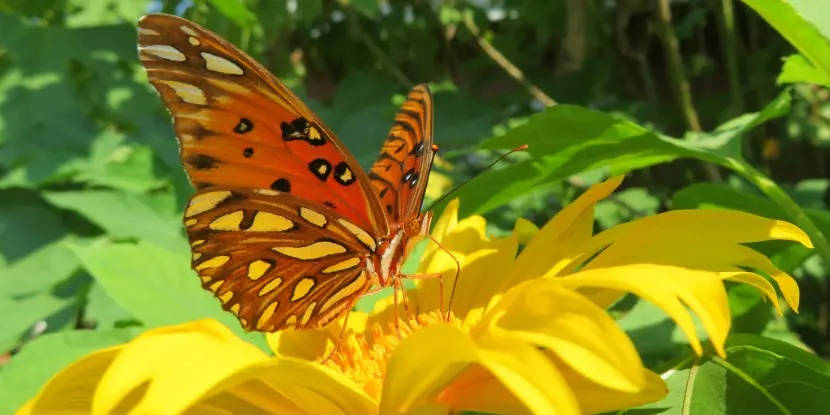
A beautiful Gulf Fritillary butterfly on yellow flower.
Cabbage White (Pieris rapae)
This European immigrant peaks during the spring and fall. Its life cycle is around 4 weeks from egg to adult, and it can produce multiple generations per year. Although a non-native species, it’s an important pollinator in Southern California gardens, particularly for plants in the Brassica family, like broccoli and kale.
California Dogface (Zerene eurydice)
California’s state butterfly is a charmer with its yellow wings and distinctive black “dog face” on the male. Its life cycle is around 3 weeks from egg to butterfly, and it appears in Southern California year-round.
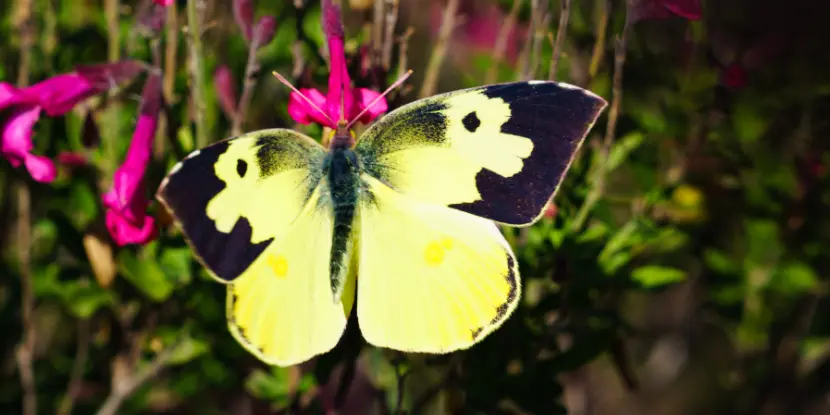
California Dogface butterfly feeding on a fuchsia flower. Woof woof!
Anise Swallowtail (Papilio zelicaon)
The Swallowtail is a large, striking butterfly with yellow and black wings. It visits Southern California in spring and summer.
Carrot family plants (Apiaceae) are the Anise Swallowtail caterpillar’s primary food, particularly fennel, dill, and parsley.
Plants & Practices for a Butterfly Garden
The goal is to create an environment with food, shelter, water, and places for butterflies to lay their eggs.
Nectar Plants
These have nectar-producing flowers that nourish adult butterflies.
- Milkweed is the only food source for Monarch caterpillars. It also provides nectar for Monarch adults and many other butterfly species.
- Passion Vine is the larval food plant for the Gulf Fritillary. Its striking flowers are a bonus, attracting various pollinators.
- California Lilac supports a range of butterflies and is a native shrub that requires minimal water once established.
- Lantana is a hardy, drought-tolerant plant that blooms year-round in Southern California.
- Native Sages attract butterflies and bees, providing nectar and habitat.
- Butterfly Bush is a non-native shrub with clusters of fragrant flowers.
- Zinnias, cosmos, verbena, and marigolds are other popular choices for nectar plants.
Host Plants
Butterflies lay their eggs on host plants, and caterpillars feed on them. A mix of native and non-native host plants will attract a range of butterfly species.
- California Buckwheat is a native plant that supports numerous butterflies, particularly in the larval stage.
- Fennel, dill, and parsley (Apiaceae family) attract Anise Swallowtails for egg-laying and caterpillar development.
- Pipevine is a native vine favored by the Aristolochia butterfly, or California Pipevine Swallowtail.
- Milkweed, milk thistle, and hollyhock are host plants for the Painted Lady.
- Senna (Cassia spp.) is a favorite host plant for the Sulphur Butterfly.
- Yarrow attracts painted ladies and other species by offering a landing spot and nectar.
- Goldenrod blooms late in the season, providing vital nectar for butterflies preparing for migration or overwintering.
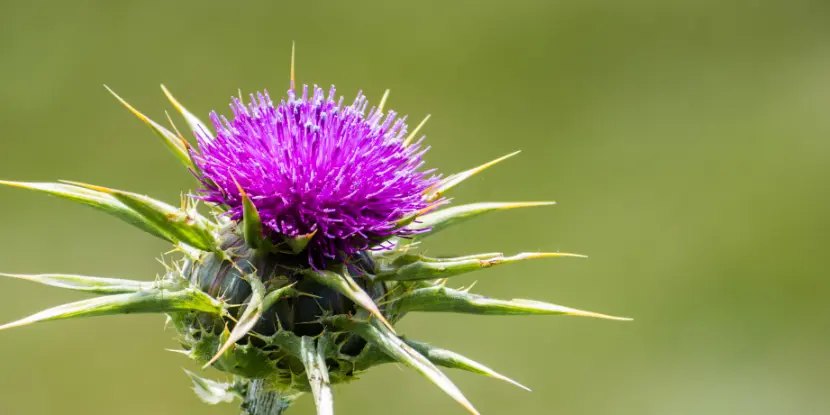
The Milk Thistle is a host plant for the Painted Lady butterfly.
Shelter Plants
Shelter plants hide butterflies from predators, protect them against harsh weather, and give them spaces to roost. In Southern California, these include:
- Toyon: An evergreen shrub with dense foliage and red berries.
- Manzanita: Known for its dark red bark and resilience, Manzanita provides shelter and nectar for adult butterflies.
- California Coffeeberry: This shrub, with dense growth and nectar-rich flowers, supports butterflies and attracts other beneficial wildlife.
- Coast Live Oak: A large tree with a protective canopy for butterflies and other wildlife.
- Coyote Brush: This hardy plant is ideal for a low-maintenance butterfly garden.
- Mugwort: Its aromatic leaves deter pests and contribute to a safer habitat.
- Matilija Poppy: Large, fragrant flowers and bushy growth provide cover and nectar.

Manzanita is a striking but drought-tolerant plant that offers cover for butterflies.
Gardening Practices
- Avoid using pesticides. Opt for natural pest control methods, like attracting beneficial insects and birds to your garden.
- Provide water, like a shallow dish or saucer with pebbles offering hydration and a place to rest.
- Plant in groups to make it easy for butterflies to find nectar and enhance plant pollination.
- Leave a few areas of bare ground. Some butterflies require open spaces for basking or laying eggs.
- Use various plant heights and textures to build layers that support different butterfly species and protect them from wind and sun.
- Consider your climate zone when selecting plants. Some butterfly-friendly plants are more suitable for Southern California’s Mediterranean climate than others.
Location & Design
Location
- Butterflies are ectothermic and need warmth to become active. Choose a sunny, open area protected from strong winds.
- Barriers like hedges or fences can buffer butterflies from harsh weather.
- Areas near water sources can serve as hydration points for butterflies.
- Proximity to existing butterfly populations or natural areas increases the chance of attracting diverse butterfly species.
Design
- A butterfly garden can be a designated area or incorporated into an existing garden.
- Add elements like rocks, logs, and branches as perches for butterflies.
- Mix plants with different colors and bloom times.
- Native plants are generally more sustainable and require less maintenance than non-native options.
- Create a diverse environment by incorporating various nectar, host, and shelter plants.
- Consider the size of your garden and plant accordingly. With the appropriate plants, a small garden can support a profusion of butterflies.

Just like a weekend warrior, butterflies need hydration.
Maintaining Your Butterfly Garden
Watering
- Water deeply but infrequently to encourage deep root growth, which helps plants survive dry conditions.
- Early mornings or late evenings are the best times to water. This reduces evaporation and directs more water to the roots.
- For nectar plants and delicate flowers, consider installing drip irrigation or a soaker hose to keep foliage dry and disease-free.
Deadheading
- Remove spent flowers to encourage continuous blooming and keep nectar plants in bloom longer.
- Use sharp, sterilized scissors or pruners to cut off faded blooms just above the next set of leaves or buds.
Pruning
- Prune plants to maintain shape, promote healthier growth, remove dead or diseased branches, and allow airflow for all garden inhabitants.
- Prune shelter plants like shrubs and small trees in late winter or early spring before new growth starts.
- Be mindful of host plants. Avoid heavy pruning during peak egg-laying seasons.
Dealing with Pests & Diseases
- Watch for unwanted caterpillars that may munch on your plants, and consider planting extra host plants to accommodate them.
- Use natural pest control methods, such as beneficial insects or handpicking pests off plants.
- If necessary, apply organic sprays or solutions to combat pests without harming beneficial insects and pollinators.
- Monitor your garden for signs of plant diseases. Address any issues promptly to prevent diseases from spreading.
FAQs: Creating a Butterfly Garden
Q: How can I attract butterflies to my garden?
Plant various nectar-rich flowers and provide water sources to attract butterflies.
Q: Do I need to plant specific plants to attract certain butterfly species?
Different butterfly species have specific preferences for host and nectar plants, so research the species in your area to meet their needs.
Q: How can I deal with caterpillars eating my plants?
Plant extra host plants to accommodate caterpillars, or use natural pest control methods, such as handpicking pests off plants or introducing beneficial insects.
Q: Can I still have a butterfly garden if I live in an apartment or small space?
Even with limited space, you can attract butterflies by gardening in containers and hanging baskets with nectar-rich flowers on a balcony.
Q: What are some butterfly-friendly plants for a Mediterranean climate?
Consider planting native species like Milkweed, California Buckwheat, and Purple Sage. These plants thrive in the region and provide food and habitat for butterflies.
Q: How can I provide water for butterflies in my garden?
Place a shallow dish filled with water and pebbles in your garden. The pebbles will offer a place for butterflies to perch while they drink.
Q: Is it possible to attract butterflies year-round?
Attracting butterflies year-round requires planting species that bloom at different times of the year. Including evergreen plants and creating sheltered areas can make your garden more inviting throughout the seasons.
Q: What role do host plants play in a butterfly garden?
Host plants provide food for caterpillars and a place for butterflies to lay eggs. Some common host plants include Milkweed for Monarchs and Willow for Viceroys.
Q: How can I make my garden environmentally sustainable while attracting butterflies?
Use native plants, conserve water with efficient irrigation methods like drip systems, and avoid chemical pesticides. Composting and mulching can also improve soil health, making the garden more resilient.

